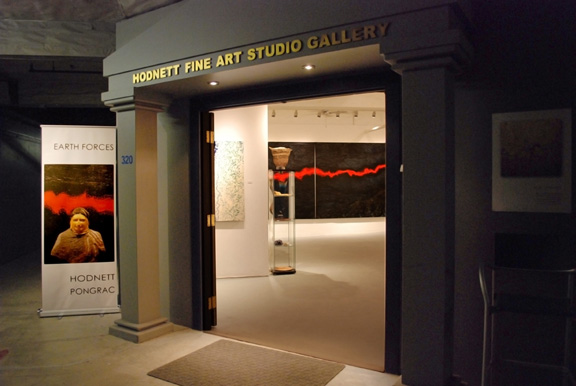
EXHIBITION PHOTOS
EARTH FORCES
An exhibition of fibre works by Julie Pongrac and paintings by Noel Hodnett
December 1, 2011 - January 31, 2012

Entrance to the exhibition.
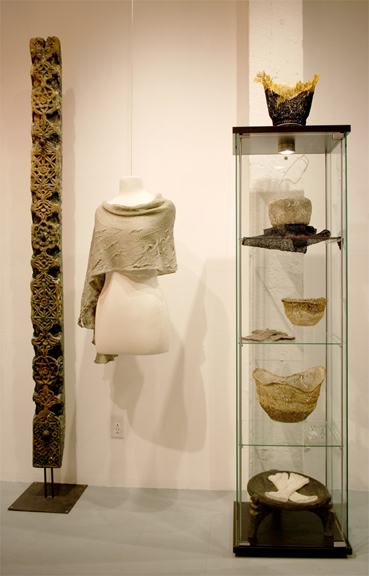
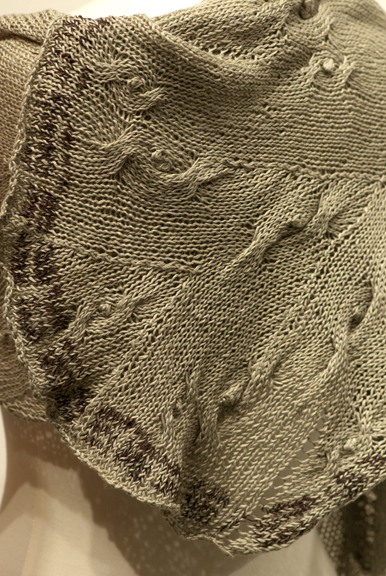
"Oyster Wrap" (with detail) and Lava bowls by Julie Pongrac with Zanzibar door post.
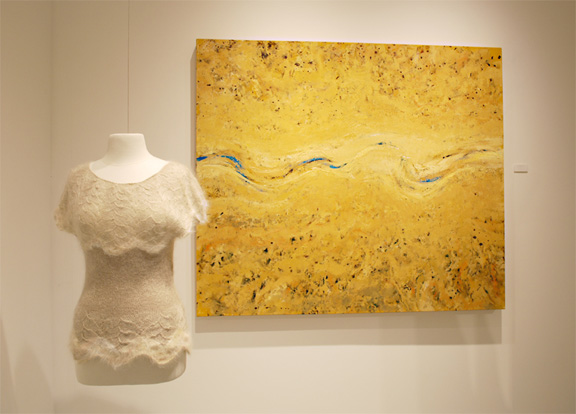
"Mountain Grasses Top" by Julie Pongrac and "e-Scape #5" by Noel Hodnett
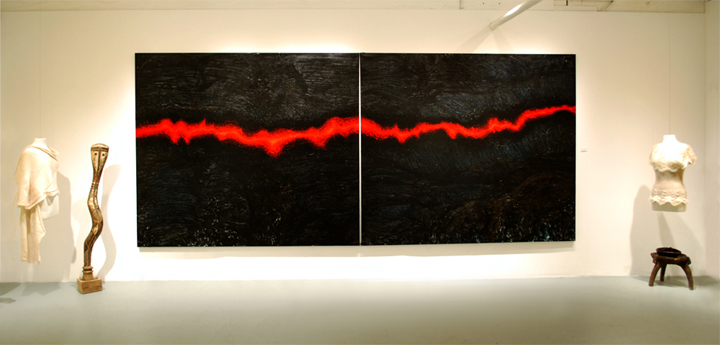
"e-Scape #4" by Noel Hodnett flanked by "Summer Grasses Wrap" (right) and "Mountain Grasses Wrap" (left) by Julie Pongrac.
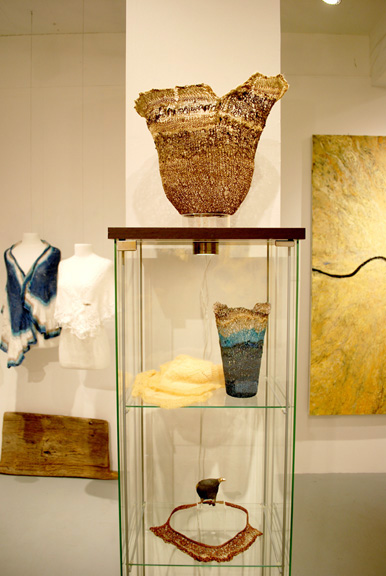
.jpg)
Show case with "Lava Bowl #1" (top and detail left), "Atoll Vessel" and "Canary Jabot" (centre) and "Bark Neckpiece" (bottom) by Julie Pongrac
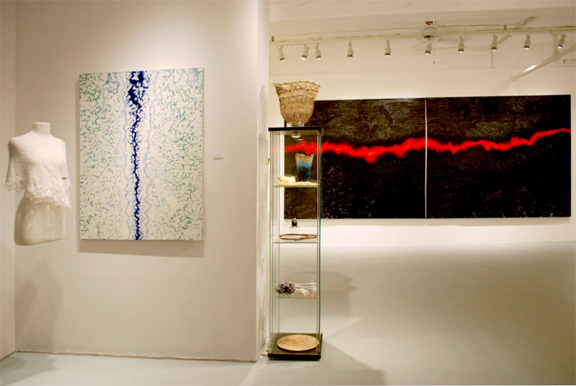
"Winter Leaves Wrap" by Julie Pongrac with "e-Scape #1" by Noel Hodnett (left). Show Case with works by Julie Pongrac and "e-Scape #4" in background.
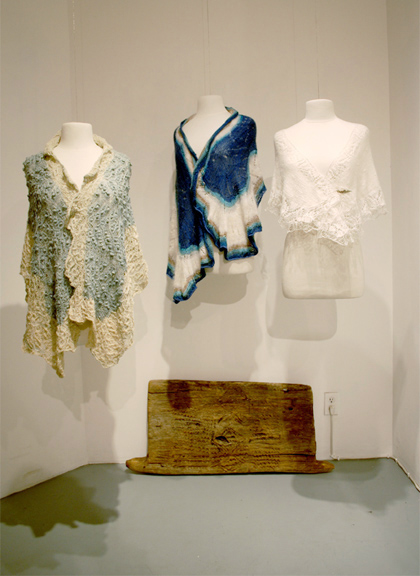
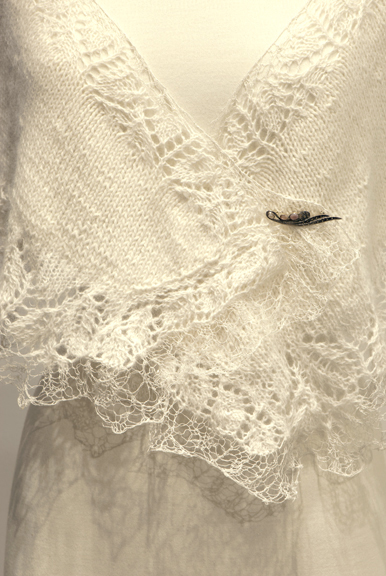
"Lacecap Hydrangea Wrap" (left), "Atoll Wrap" (centre) and "Winter Leaves Wrap" (right and detail) by Julie Pongrac with Venda tribal door.
|
EARTH FORCES - An exhibition of works by Noel Hodnett and Julie Pongrac The works on this exhibition have been informed by both earth forces and ethnic design rhythms. Some pieces are designed to be worn as artworks while others are simply objects to be admired. The fabric “bowls” are in fact not bowls at all. They are not designed to hold anything. They are purely sculptural pieces informed by atolls, lava flows and the possibilities of the fibers used in their creation. If the distinction between art and craft is functionality, then these works hopefully challenge that perception. Unlike the paintings, what is central to the fabric works is that the process of constructing the individual pieces is highly mathematical and by no means random, yet the final design appearance often is…as it is in Nature. Like most sculpture, the final forms, along with their seemingly random surface designs, have to be thought out in advance and constructed, deconstructed and re-constructed before the piece can take on its final form. The paintings, although informed by the same earth forces as the fabric works, have been resolved in a very different manner. They are initially created from a series of random, subconscious marks layered on the canvas in contrast to the strictly formal process employed in the fabric pieces. These random marks take on a more focused quality as the painting progresses and ultimately culminate in a composition that owes itself to an intimate knowledge of form, colour and subject matter. Apart from the process and medium, the main distinction between these two art forms is that one has a relatively predictable resolution point whereas the paintings often end up being very different form the original concept. Both the paintings and the fabric work are often completely deconstructed and reconstructed if they are not “working” aesthetically or have become bogged down in the process. The paintings however always retain the history of the process whereas the fabric works seldom do. What these works do have in common is their adherence to a philosophy of truthfulness to their respective mediums and processes. As with most contemporary art, what may look easily achieved is usually quite the opposite. The times when a solution is indeed easily achieved are purely due to experience and an accumulated knowledge of the subject and the materials at hand…and of course, an element of luck. The exhibition runs from December 1, 2011 to January, 2012 Artists' Statements regarding the work on exhibition
About the Fibre Works These fibre works explore colour and form from a non-traditional perspective of knitting. The process explores the idea of the aesthetic informing the work rather than the traditional notion of pattern drafting. The critical element to each piece is a clear inspiration and intention. Whether it is functional or non-functional does not matter. In fact, the developing design elements will often dictate the final form and therefore function. It is a very organic method of process that removes many constraints that traditionally limit the subject matter with regard to this medium. For this reason, I can explore the graceful curves and colouration of a lacy coral Atoll in the ocean as easily as the concentric circles intrinsic to an organism like lichen. In distilling the process down to the basic elements of the subject matter, the pieces take on a timeless quality…or primitiveness. It is my experience that simple and natural design requires more skill, not less, to achieve. Achieving success with any one piece requires an in-depth understanding of how the basic unit, in this case a knit stitch, can be repeated and permutated to create a curve or textured surface…even a structural form. When thinking in these mechanical terms…rather than the traditional teachings of any one culture about the craft…the gusset of the heal of a sock becomes the corner of a box structure, etc., etc. Understanding as many traditional techniques as possible provides a rich tool box for creating contemporary works that can be mined extensively with the appropriate paradigm shift. It also challenges the notion that a contemporary aesthetic can be created without an in-depth knowledge of the traditional craft. I most definitely believe this to be impossible. It is like saying that contemporary art should be created devoid of the knowledge of art history. Having embraced the philosophy of more knowledge provides more opportunity for creativity, the designs in this collection typically contain fibres that are hand-spun and/or hand-dyed. The aesthetic beginnings of a piece may require a visit to the dye pot, several experiments and fibre of various kinds before the appropriate colour and texture is found to even create the yarn. In essence my “painting process” begins with organic substrates and knowledge of chemistry for extracting the appropriate colour and patina for which I prefer natural dyes. These subtle irregularities can be worked in or out of the process by blending the fibre(s) before spinning. So by dying and spinning the fibres I have in essence a full colour palette at my disposal. It does however, not discourage me from the use of commercially available yarns. A broad knowledge of the properties of fibres, including modern technical fibres, further add to the flexibility. For instance, I find that silk covered stainless steel and fly fishing Kevlar wire have frequently found their way into my work. My only rule of thumb is to let the aesthetic govern the process. Finally, one needs to reflect on the choice of subject matter. Most of my work brings into focus raw elemental features of the environment. They may be the result of volcanic signatures such as salt and sulphur crusts, coral reefs of Atolls and lava flows or primitive organisms such as grasses, lichens, mushrooms and oysters. What makes them possible to depict in these works is an underlying mathematical sequence of regular and irregular repeated patterns and fractals. What on the surface appears random is in fact deliberately ordered in construction. In bringing these works together and in focus with ethnic artefacts, my hope is to encourage a re-evaluation of what is primitive and contemporary and what is craft and art. Julie Pongrac December 2011 About the Paintings. These paintings explore landscape elements from a perspective that was not immediately available to someone merely walking through it…until fairly recently. It is a perspective courtesy of satellite technology. Such a viewpoint not only challenges the way we see things in visual recessionary terms, but gives us a more holistic perspective of the landscape in which we find ourselves. Thanks to Google Earth™, this view from Space allows one to visually explore the landscape in a way that was not available to the Old Masters. It has also allowed contemporary artists to go beyond accepted academic principles that have traditionally determined the way a landscape was rendered. This phenomenon has however not released the artist from any responsibility of understanding the landscape in human terms. I believe it is important that artists understand the fundamentals of mark-making and especially the process of translating a perceived third dimension into a series of marks on a two dimensional surface…especially when working from photographs which have supposedly solved this translation problem. I say ‘supposedly’ because photography has a distinctive way of distorting an image depending on the type of camera and lens used to capture the original image. One only has to look at a photo of an aircraft’s spinning propeller captured with an iPhone™ and compare it to an image using a traditional camera. Both images are distorted in a very different way, but, the process of translation from reality to image is never-the-less largely taken out of the artist’s hand. It is precisely the eye-hand coordinated mark-making that sets artists apart from “picture-makers” who usually have to resort to the filter toolbox in Photoshop™ in order to render an image. What becomes immediately apparent when looking at images of the Earth from Space are the numerous fissures caused by glacial, seismic, volcanic, water action, animals…and of course, human beings. Exploring this perspective allows for an alternative approach to the traditional Renaissance laws of composition. There is no sky or horizon nor foreground or background. It is full-in-your-face land without the traditional ‘scape’…an e-Scape, perhaps. Although the technology that has informed these works is relatively new, the process of constructing, de-constructing and re-constructing the paintings is certainly not. In the early 1960’s French painter Jean Dubuffet did paintings of city street scenes where the entire surfaces of the canvases were covered in “flattened” cars, people and buildings as if seen from above. The paintings were obviously not done from photographs but with a deep understanding and first-hand visual awareness of his surroundings. The paintings were the precursors to his “l’hourloupe” series for which he is arguably most famous. Other artists such as Australian painter Fred Williams and America’s Richard Diebenkorn individually explored the landscape in a manner which could have been informed by aerial photographs, but they too were working well before satellite imagery became available at the touch of a touch screen. In fact, some of the greatest artworks ever done, i.e. the cave paintings of Lascaux and Chauvet and Altamira, do not concern themselves with any rules of perspective whatsoever. Only one painting on this exhibition (“Badlands”) explores the line where earth meets sky. This 2010 painting has been included as a comparative example of a relatively traditional approach to landscape composition, which essentially deals with the same elements as the other works, but has been resolved in a very different way. I am however hoping that this exploratory body of work will inform future work in a way I could not imagine. Noel Hodnett December 2011
|
hfa contemporary
320 - 1000 Parker Street,
Vancouver, B.C. V6A 2H2
CANADA
Tel: +1-604-876-7606
Viewing: By appointment.
e-mail:
hfacontemporary@gmail.com
© Copyright Noel Hodnett - 2011 - All rights reserved.